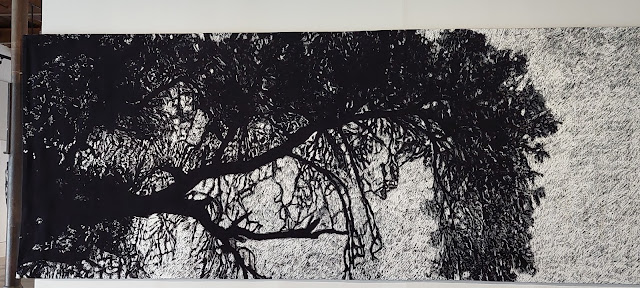During our Christmas trip in Oaxaca, we needed to get out of town. It's always fun to travel with others but it's hard to get up and going. We found ourselves sticking mostly to the central part of the city. I did take a taxi to go grocery shopping one day. After all, we did have a complete apartment with a working kitchen.
The best way for me to find a place to visit is to use Google maps. I started at Oaxaca (the city) and looked to see what was in a radius of less than an hour by bus. The first thing that popped up was the town of Etla. I went back to Google search to see what I could find out about the town and if it was known for anything in particular. Sure enough, it was known for the giant textile factory that was in existence from 1883 until its transformation into an arts center in the 1950s. A famous painter, Francisco Toledo, was looking for a place for artists to do what they do best. He wanted to give them a place and an opportunity to paint and create textiles, and pottery. Along with Jose Zarilla Trapaga, who had a dream of restoring the buildings, they created the first ecological Arts Center of Latin America. Today it is called CASA or Centro de Arte San Agustin.
Taxis are very expensive for groups and vans as well. We had prices in the 1800 to 2000 peso price range. It just so happened that Juan and I had lunch with a teacher we have worked with for years. She has taught English in the state program for over 35 years and also has a bookstore in the downtown area (school text for language learning). I asked her about going to Etla and the best way to get there. She put us in contact with a retired teacher who gives tours and has a van. It worked out well. We paid 200 pesos per person and he took us there and stayed for the almost five-hour trip. It turns out that he is well-versed in the arts center.
The generator room that provided power to the factory was generated by water that flows through the river on the property.
Steam stack on top of the main factory floor. Now there are reflective pools and fountains that surround it.
The current gallery selection is enormous textiles with scenes woven into them. That may not be the best way to describe it. Also, there is the history of the factory along with the transformation. He wandered around as well as we did and answered any questions we had. It was a good choice.
These are massive weaves made from silver photographs. The detail is amazing. The photographs hang on the sides of the factory walls.
Apart from the art and the story of the textile factory, Etla supplies most of the water to the city of Oaxaca. Oaxaca has a city water system but the water is not good quality. Most people buy their water from a pipa (small tanker truck). The trucks, just like LP gas, drive around and make scheduled stops. Long hoses are used to fill cisterns. It's a mess. You'll always hear the generators from the trucks pumping water. Fortunately, Monterrey has a wonderful water system and also natural gas lines for all the homes in the metro area.
Factory floor where the spinning machines were located.
Rooftop view of the surrounding mountains.
 |
After we were finished, we found a small fondita or house that has a small outdoor restaurant. The food was delicious and our waitress didn't speak English or Spanish. She is from an indigenous rural community and is learning to speak Spanish. We had coffee and chatted with the owner for a bit. We headed back home and I had hoped to plan another day trip but we ran out of time. We can always go back.







.jpg)
.jpg)





Nice blog post with great photos. https://www.footslopestours.com Thank you for sharing such a great information.
ReplyDeleteWhat a great day! Beautiful pictures.
ReplyDelete